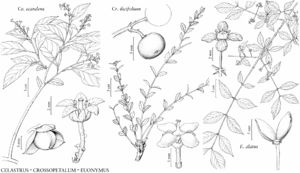Difference between revisions of "Euonymus alatus"
Verh. Batav. Genootsch. Kunst. 12: 49. 1830. (as Evonimus)
FNA>Volume Importer |
imported>Volume Importer |
||
| (One intermediate revision by the same user not shown) | |||
| Line 6: | Line 6: | ||
|place=12: 49. 1830 | |place=12: 49. 1830 | ||
|year=1830 | |year=1830 | ||
| + | |other_info_on_pub=(as Evonimus) | ||
}} | }} | ||
|common_names=Oriental spindle-tree | |common_names=Oriental spindle-tree | ||
| Line 17: | Line 18: | ||
|basionyms={{Treatment/ID/Basionym | |basionyms={{Treatment/ID/Basionym | ||
|name=Celastrus alatus | |name=Celastrus alatus | ||
| − | |authority=Thunberg | + | |authority=Thunberg |
|rank=species | |rank=species | ||
| − | |publication_title=Syst. Veg. ed. | + | |publication_title=in J. A. Murray, Syst. Veg. ed. |
|publication_place=14, 237. 1784 | |publication_place=14, 237. 1784 | ||
}} | }} | ||
| Line 41: | Line 42: | ||
|elevation=0–400 m. | |elevation=0–400 m. | ||
|distribution=Ont.;Conn.;Del.;D.C.;Ga.;Ill.;Ind.;Iowa;Kans.;Ky.;Maine;Md.;Mass.;Mich.;Minn.;Mo.;Mont.;N.H.;N.J.;N.Y.;N.C.;Ohio;Pa.;R.I.;S.C.;Utah;Vt.;Va.;W.Va.;Wis.;e Asia. | |distribution=Ont.;Conn.;Del.;D.C.;Ga.;Ill.;Ind.;Iowa;Kans.;Ky.;Maine;Md.;Mass.;Mich.;Minn.;Mo.;Mont.;N.H.;N.J.;N.Y.;N.C.;Ohio;Pa.;R.I.;S.C.;Utah;Vt.;Va.;W.Va.;Wis.;e Asia. | ||
| + | |introduced=true | ||
|discussion=<p>The leaves of <i>Euonymus alatus</i> become bright red or reddish purple in fall, one of the reasons for its widespread use as an ornamental.</p> | |discussion=<p>The leaves of <i>Euonymus alatus</i> become bright red or reddish purple in fall, one of the reasons for its widespread use as an ornamental.</p> | ||
|tables= | |tables= | ||
| Line 65: | Line 67: | ||
|publication year=1830 | |publication year=1830 | ||
|special status=Introduced;Illustrated | |special status=Introduced;Illustrated | ||
| − | |source xml=https:// | + | |source xml=https://bitbucket.org/aafc-mbb/fna-data-curation/src/2e0870ddd59836b60bcf96646a41e87ea5a5943a/coarse_grained_fna_xml/V12/V12_798.xml |
|genus=Euonymus | |genus=Euonymus | ||
|species=Euonymus alatus | |species=Euonymus alatus | ||
Latest revision as of 19:17, 5 November 2020
Shrubs 1–4(–7) m. Stems erect; young branches 4-angled, becoming corky winged. Leaves deciduous; petiole 0.5–4 mm; blade narrowly elliptic, 2.5–6 × 0.5–2.5 cm, base attenuate or cuneate, margins denticulate, apex acuminate. Inflorescences axillary, (1–)3(–7)-flowered. Flowers: sepals 4; petals 4, yellowish green or white, oblong, 2–3 × 1.5–2 mm; stamens 4; ovary smooth. Capsules purple-brown, obovoid, 8–10 × 5–15 mm, deeply 2–4-lobed to base or only 1 lobe developing, lobes nearly distinct, surface smooth. Seeds ellipsoid, 7–8 × 4–5 mm; aril yellow or orange. 2n = 64.
Phenology: Flowering spring–fall; fruiting summer–fall.
Habitat: Roadsides, old fields, thickets, woodlands.
Elevation: 0–400 m.
Distribution

Introduced; Ont., Conn., Del., D.C., Ga., Ill., Ind., Iowa, Kans., Ky., Maine, Md., Mass., Mich., Minn., Mo., Mont., N.H., N.J., N.Y., N.C., Ohio, Pa., R.I., S.C., Utah, Vt., Va., W.Va., Wis., e Asia.
Discussion
The leaves of Euonymus alatus become bright red or reddish purple in fall, one of the reasons for its widespread use as an ornamental.
Selected References
None.
